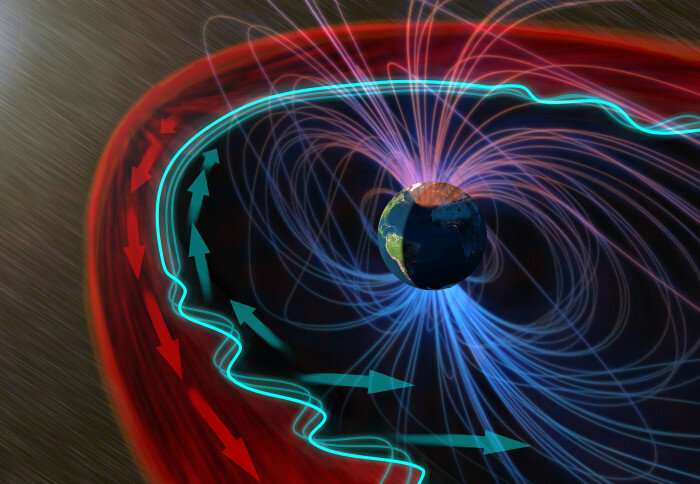Energy from the solar wind interacting with the magnetospheric 'bubble' around Earth creates waves of energy that appear to stand still.
This new finding, from research led by Imperial scientists, improves our understanding of the conditions around Earth that contribute to 'space weather', which can impact our technology from communications satellites in orbit to power lines on the ground.
The Sun releases a stream of charged particles called the solar wind. On the Earth's surface, we are protected from this barrage by the magnetosphere—a bubble created by the Earth's magnetic field.
When the solar wind hits the magnetosphere, waves of energy are transferred along the boundary between the two. Scientists thought the waves should ripple in the direction of the solar wind, but the new study, published today in Nature Communications, reveals some waves do just the opposite.
Standing waves
Previously, lead researcher Dr. Martin Archer, from the Department of Physics at Imperial, and his colleagues established the magnetosphere's boundary vibrates like a drum. When a drumstick-like pulse from the solar wind strikes the very front of our magnetospheric bubble, waves race toward Earth's magnetic poles and get reflected back.
The latest work considers the waves that form across the entire surface of the magnetosphere, using a combination of models and observations from NASA's THEMIS (Time History of Events and Macroscale Interactions during Substorms) satellites.
The researchers found when solar wind pulses strike the magnetosphere, the waves that form not only race back and forth along Earth's field lines, but also travel against the solar wind.
Movie of the simulation results at the equator (left) and noon meridian (right). The boundary of the magnetosphere (black) moves due to surface waves, which compresses (red) or rarefies (blue) the magnetosphere. The oscillations have also been converted into accompanying audio. Credit: Imperial College London
The team used models to illustrate how the energy of the wind coming from the Sun and that of the waves going against it could cancel each other out, creating 'standing waves' that involve a lot of energy but appear to go nowhere.
Dr. Archer said: "It's similar to what happens if you try walking up a downwards escalator. It's going to look like you're not moving at all, even though you're putting in loads of effort."
These standing waves can persist longer than those that travel with the solar wind. That means they're around longer to accelerate particles in near-Earth space, leading to potential impacts in regions like Earth's radiation belts, aurora, or ionosphere.
The researchers also say that standing waves may occur elsewhere in the universe, from the magnetospheres of other planets to the peripheries of black holes.
Waves of sound
The researchers also translated the electromagnetic signals from the THEMIS satellites into audio, allowing us to listen to the sounds of the waves traveling across the magnetospheric boundary.
Dr. Archer added: "While in a simulation we can see what's going on everywhere, satellites can only measure these waves where they are giving us only time-series, wiggly lines. This sort of data is actually best suited to our sense of hearing than sight, so listening to the data can often give us a more intuitive idea of what's going on.
"You can hear the deep breathing sound of the standing surface waves persist throughout, rising in volume as each pulse hits. Higher pitched sounds, associated with other types of waves, don't last nearly as long."
- Karlston
-

 1
1



Recommended Comments
There are no comments to display.
Join the conversation
You can post now and register later. If you have an account, sign in now to post with your account.
Note: Your post will require moderator approval before it will be visible.